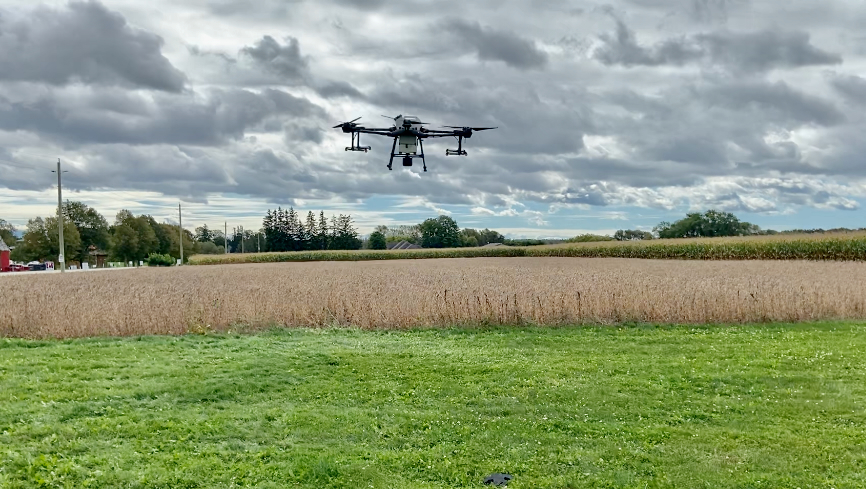Farmers want data strategy | Farmtario

Data will drive productivity growth on Canadian farms, farm organizations told agriculture ministers last month.
Read Also

Spray drones just waiting to go
There have been few technologies in waiting with as much pent-up interest as agricultural drones. The unmanned flying machines started…
They called for a national data strategy during a round table discussion at the Canadian Federation of Agriculture summer meeting and ahead of the federal-provincial-territorial annual ministerial meeting.
Why it matters: Data-driven technologies will help farmers meet sustainability and productivity goals, but governance and management of data are major hurdles.
“The agriculture sector is in the midst of a transition characterized less and less by diesel and more and more by data,” said CFA first vice-president and Saskatchewan grain farmer Todd Lewis.
He told the ministers the low-hanging fruit that drove productivity is gone. Agricultural productivity around the world has declined since 2011, according to a 2023 Farm Credit Canada report.
“FCC, RBC, the OECD and FAO all agree — if we want to reverse this trend, and improve our productivity growth, we need to invest in innovation and data-driven technologies,” Lewis said.
This would generate stronger economic outcomes, support development of more responsive risk management programs and improve sustainability, he added.
Full use of data generated on farms is a ways away. A survey found less than half of farms used data to manage production, Lewis said.
CFA and its member organizations presented four recommendations to ministers:
- Form a pan-Canadian data strategy to signal to farmers and industry that the country has a plan to invest in innovation, digital skills, data management and reporting;
- Finish the job of rural connectivity;
- Devise programs to help farmers invest in digital infrastructure tools and a legislative framework to support interoperability; and
- Support standards development and capacity building for projects already underway.
Lewis said farmers’ credibility is at stake. As well, he said the forthcoming Sustainable Agriculture Strategy must be based on data if it is to succeed.
“If it isn’t, we won’t get buy-in from the sector and we won’t get the end result we are looking for on the environment. The inability to communicate (that) our data is informing policy undermines Canada’s reputation at home and abroad, and creates uncertainty around the climate for investment.”
Data ownership is one of the big questions around this topic. During a panel presentation, Prince Edward Island farmer Matthew Ramsay said farmers should leverage the governance structure of their member organizations to keep data secure.
He has done several projects for the P.E.I. Federation of Agriculture (PEIFA). One that used remotely sensed land use data and the federal Holos model quantified emissions and future reduction potential. The idea was to find how farmers could access voluntary carbon markets.
However, he said data and governance were major hurdles.
“Few farms have enough data to meet the reporting and verification requirements of carbon markets,” he told the ministers.
That also means farmers can’t use data to become more resilient and sustainable.
The future “requires a safe and secure system of managing highly complex soil carbon model data owned by farmers and managed by farm organizations,” Ramsay said.
He and others developed an agricultural Internet of Things network infrastructure that uses infield hardware and PEIFA-owned secure servers. Farmers could use the organization’s governance structure to manage data ownership and emissions reduction credits.
It’s designed to take field data, analyze it and put it back in the field, Ramsay said. It’s only possible if data exists in a common format and place, however.
He and several universities have already done work showing significant dollar savings and nitrous oxide emissions reductions using map data. He said that work led him to conclude that having farmer-owned data, all in one place and governed by existing democratic farm organizations, can prove to farmers and stakeholders that changes in practices are providing ecosystem services.
Producer participation
Tyler Fulton, vice-president of the Canadian Cattle Association and president of Manitoba Beef Producers, said the beef industry is so dependent on trade that science-based metrics are key.
That has to be true abroad and at home, he said.
However, the industry is challenged by low uptake in programs such as Verified Beef Production Plus and the Canadian Roundtable for Sustainable Beef, which provide valuable data.
“Speaking on behalf of the export-oriented sector, we need voluntary third party certifications that work with government,” he said during the round table.
“In the United States, they have the Agricultural Marketing Services, or AMS, that verifies that process and certifies third parties. We would like to see Canada have a similar system through AAFC across the board, both for domestic and international purposes. Working with third party verifiers would help AAFC collect data without adding additional burdens on producers.”
Both Saskatchewan and Alberta have incentives for producers to sign on, and Fulton said industry-led initiatives are also important. Data gives the sector potential to “leapfrog” ahead.
“Satellite remote sensing technology is really a game changer for land management and managing range land and pasture.”
Genetic evaluation tools that didn’t exist three years ago are now commercially available, he said. Individual rumen boluses could report data on those animals and their health outcomes.
“There’s just a phenomenal amount of data and potential to lever that into real positive economic outcomes for ranchers and farmers,” Fulton said.
Data can inform policy
Better data on what’s happening in farm fields may have prevented the controversy over the federal fertilizer emissions reduction target. Frank Annau, director of product stewardship at Fertilizer Canada and co-chair of the working group on fertilizer emissions reductions under the SAS, said recommendations are developed but are under embargo.
However, he said there is a pressing need to update the national inventory report of greenhouse gas emissions with better data about farm practices that reduce emissions.
“We also believe that data reporting capacity must be enhanced for experts to provide better knowledge extension at the farm level. And most importantly, any farms that collect data must receive direct economic return if they want to voluntarily share, and sharing must be voluntary,” he said during his presentation.
Annau used federal carbon offset credits as an example of how farmers could be rewarded. They could receive credits in exchange for data on reduced emissions.
He also said farmers must be confident their data will be kept confidential.
Ministers were receptive to the idea of improved data management but said better connectivity and more money are required.
New Brunswick agriculture minister Margaret Johnson said the province recently invested in a digital chair for agriculture at the University of New Brunswick.
She said governments “need to recognize the urgency of incorporating digital systems and at the same time must assure, with the help of the federal government, that with this need for digital and cellular technology … that rural Canada has access to that stuff.”
Several ministers noted how much their provinces have spent on rural connectivity, but there is still a long way to go and billions to be spent. Manitoba minister Ron Kostyshyn said federal dollars are required to help provinces get there.
Ontario minister Rob Flack said Ontario’s largest dairy, at 3,300 cows, is in his riding, along with the largest chicken processing plant and hundreds of other farms and agricultural businesses that rely on connection.
“When I drive through my riding, I lose connection all the time, so if you’re not connected, none of this matters,” he said. “I would maybe ask a pointed question: will somebody else step up and help us out?”
Federal minister Lawrence MacAulay said all jurisdictions are spending money and pledged to continue working with the provinces.
“Without it, none of the rest of it is any good,” he said.
CFA president Keith Currie reminded the ministers that this requires a whole-of-government approach because all of society benefits.
RJ Sigurdson, Alberta’s minister, said farmers who are more profitable will innovate quicker. That government has allocated money to the Simpson Centre for Food and Agricultural Policy at the University of Calgary to build a digital strategy for agriculture.
Source: Farmtario.com

